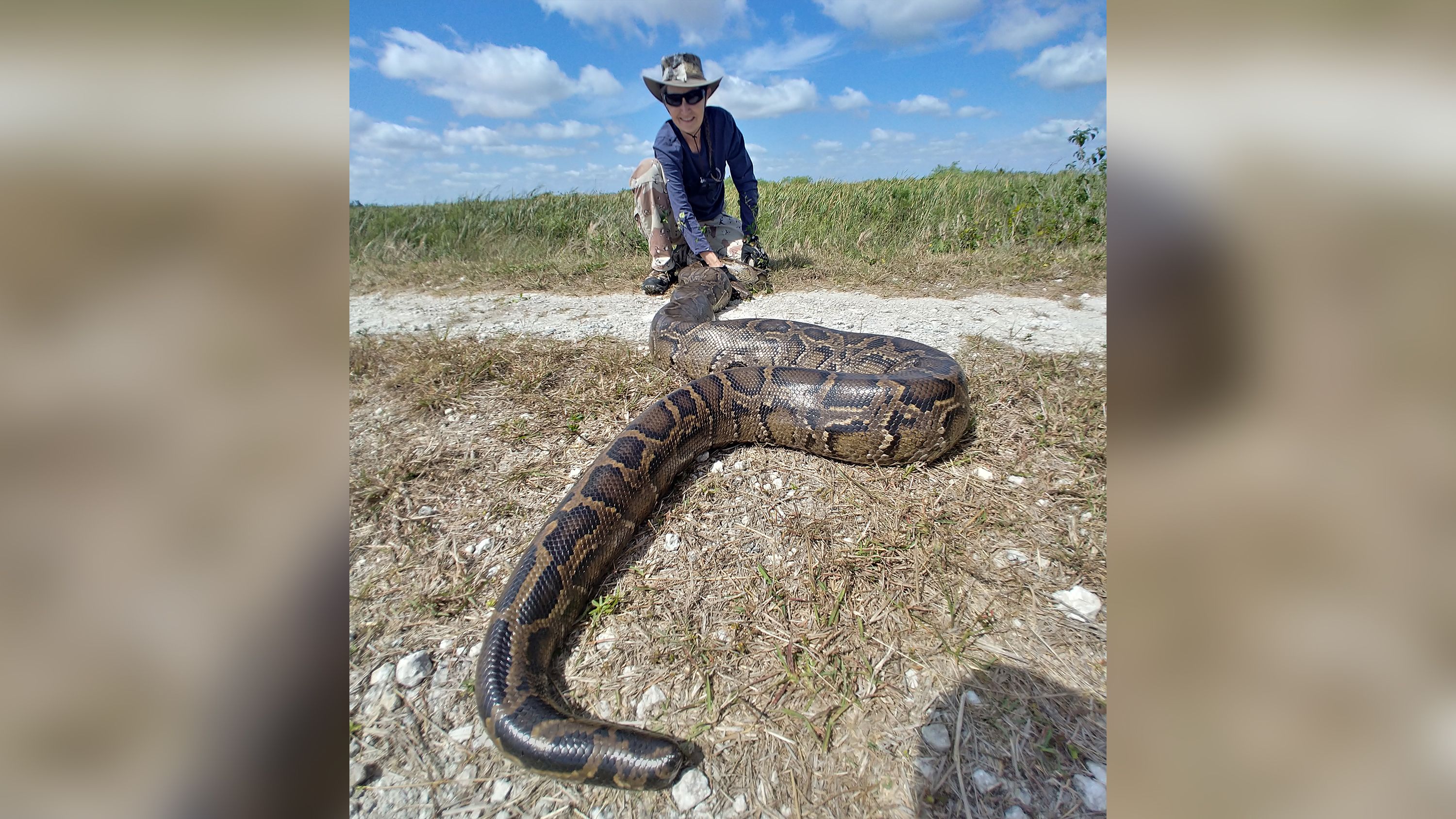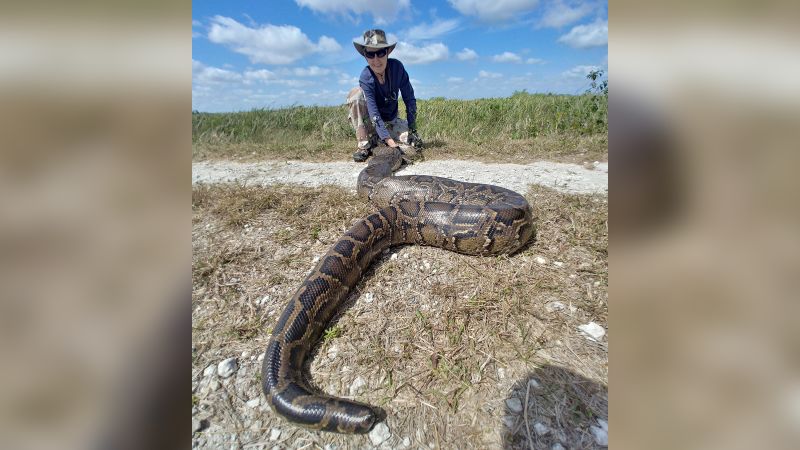The Everglades, a vast wetland in South Florida, is home to a diverse array of wildlife. However, in recent years, a new resident has taken up residence in the area: the Burmese python.
These invasive snakes have been wreaking havoc on the ecosystem, consuming native species and disturbing the delicate balance of the food chain. But just how many pythons are lurking in the Everglades, and what is being done to control their population? Let’s dive into this fascinating and concerning topic.

How Many Pythons Are in the Everglades?
The Everglades National Park in Florida is home to a diverse range of wildlife, but in recent years, a new species has made its way into the ecosystem: the Burmese python. These large, non-native snakes have been causing havoc in the park, preying on native species and disrupting the natural balance. But just how many pythons are in the Everglades?
The Invasion of the Pythons
Burmese pythons are native to Southeast Asia, but they were introduced to the Everglades in the late 20th century, likely as a result of escaped pets. Since then, their population has exploded, and they have become one of the most significant threats to the park’s biodiversity.
Estimating the exact number of pythons in the Everglades is difficult, but experts believe that there could be tens of thousands of them. The snakes are notoriously elusive and can be challenging to spot in the park’s dense vegetation. However, researchers have used a variety of methods to try and track their numbers.
One popular technique is to use trained dogs to sniff out the pythons. Another is to set up traps in areas where the snakes are known to be active. By analyzing the data collected from these methods, scientists have been able to get a better idea of the python population size.
The Impact of the Python Invasion
The Burmese pythons’ presence in the Everglades has had a devastating impact on the park’s native wildlife. The snakes are apex predators, meaning that they have no natural predators in the ecosystem. As a result, they have been able to thrive and multiply rapidly, preying on a wide range of animals.
One of the most affected species is the marsh rabbit, which has seen its population decline by as much as 90% in some areas. The pythons also prey on other mammals, birds, and even alligators, which can have a ripple effect on the entire ecosystem.
The pythons’ impact is not limited to their direct predation. They also compete with native species for resources such as food and habitat. Additionally, their presence can alter the behavior of other animals, such as causing them to avoid certain areas of the park.
The Efforts to Control the Python Population
Given the significant threat that the Burmese pythons pose to the Everglades, efforts have been underway for years to control their population. These efforts have included everything from public education campaigns to targeted removal programs.
One of the most successful removal programs has been the Python Elimination Program, which pays hunters to capture and remove the snakes from the park. Since its inception in 2017, the program has removed thousands of pythons from the ecosystem.
Another approach has been to target the snakes’ reproduction. In 2012, the U.S. Fish and Wildlife Service banned the importation and interstate transportation of Burmese pythons as pets. This has helped to reduce the number of new snakes entering the ecosystem.
The Future of the Everglades and the Pythons
Despite the efforts to control their population, the Burmese pythons are likely here to stay in the Everglades. Their ability to reproduce rapidly and adapt to new environments means that they will continue to be a significant threat to the park’s native wildlife.
However, researchers and conservationists are continuing to explore new ways to control their population and mitigate their impact. This includes everything from developing new removal techniques to studying the pythons’ behavior and biology to better understand their impact on the ecosystem.
Ultimately, the future of the Everglades and its native species will depend on the success of these efforts to control the python population. If left unchecked, the pythons could continue to wreak havoc on the park’s delicate ecosystem, with potentially devastating consequences for the entire region.
Frequently Asked Questions
Q: How many pythons are in the Everglades?
It is difficult to determine the exact number of Burmese pythons in the Everglades due to their elusive nature. According to the Florida Fish and Wildlife Conservation Commission, there could be tens of thousands of pythons in the Everglades. However, estimates vary widely, and some experts believe that there could be even more.
The python population in the Everglades is considered an invasive species and has been causing significant damage to the ecosystem. Efforts are being made to reduce their numbers, including the Python Challenge, which is a public hunt that encourages individuals to capture and remove pythons from the Everglades.
Q: How did the pythons end up in the Everglades?
The Burmese pythons are not native to the Everglades, and it is believed that they were introduced by pet owners who released them into the wild. Some pythons may have also escaped from pet stores during Hurricane Andrew in 1992. These snakes can grow up to 20 feet long and weigh over 200 pounds, making them a formidable predator in the Everglades ecosystem.
The introduction of pythons to the Everglades has had a significant impact on the native animal populations, including birds, mammals, and reptiles. The pythons have also been known to consume alligators, which are a top predator in the area.
Q: What is being done to control the python population in the Everglades?
Several measures are being taken to control the python population in the Everglades. One of the most significant efforts is the Python Challenge, which is a public hunt that encourages individuals to capture and remove pythons from the Everglades. The Florida Fish and Wildlife Conservation Commission also encourages people not to release pet snakes into the wild.
In addition to these measures, scientists are researching ways to reduce the python population, including developing traps and using dogs to locate the snakes. The hope is that by reducing the number of pythons in the Everglades, the ecosystem can begin to recover from the damage caused by this invasive species.
Q: Are pythons dangerous to humans?
While Burmese pythons are not typically considered a threat to humans, they should still be treated with caution. These snakes are large and powerful and can be dangerous if they feel threatened or cornered. In addition, some pythons may carry diseases that can be transmitted to humans, such as salmonella.
If you encounter a python in the Everglades, it is best to avoid it and contact the Florida Fish and Wildlife Conservation Commission. Do not attempt to capture or handle the snake yourself, as this can be dangerous.
Q: What is the impact of pythons on the Everglades ecosystem?
The introduction of pythons to the Everglades has had a significant impact on the ecosystem. These snakes are apex predators, which means that they have no natural predators in the area. As a result, they have been consuming large numbers of native animals, including birds, mammals, and reptiles.
The pythons have also been known to consume alligators, which are a top predator in the area. This has led to a disruption in the food chain and has had a significant impact on the balance of the ecosystem. Efforts are being made to reduce the python population in the Everglades to allow the ecosystem to recover from this damage.
Largest Burmese python in Florida history discovered in the Everglades
In conclusion, the number of pythons in the Everglades has been a topic of concern for many years. With the invasive species continuing to thrive in the area, it is difficult to determine an exact number. However, efforts to control their population through hunting and removal programs have been successful in recent years.
It is important to address the issue of pythons in the Everglades in order to protect the native species and ecosystem. While the exact number of pythons may be unknown, it is clear that their presence has had a negative impact on the area.
Moving forward, continued efforts to control the python population and prevent further introduction of invasive species will be crucial in preserving the unique and valuable ecosystem of the Everglades. With ongoing research and conservation efforts, we can strive to maintain a healthy balance in this important natural habitat.


